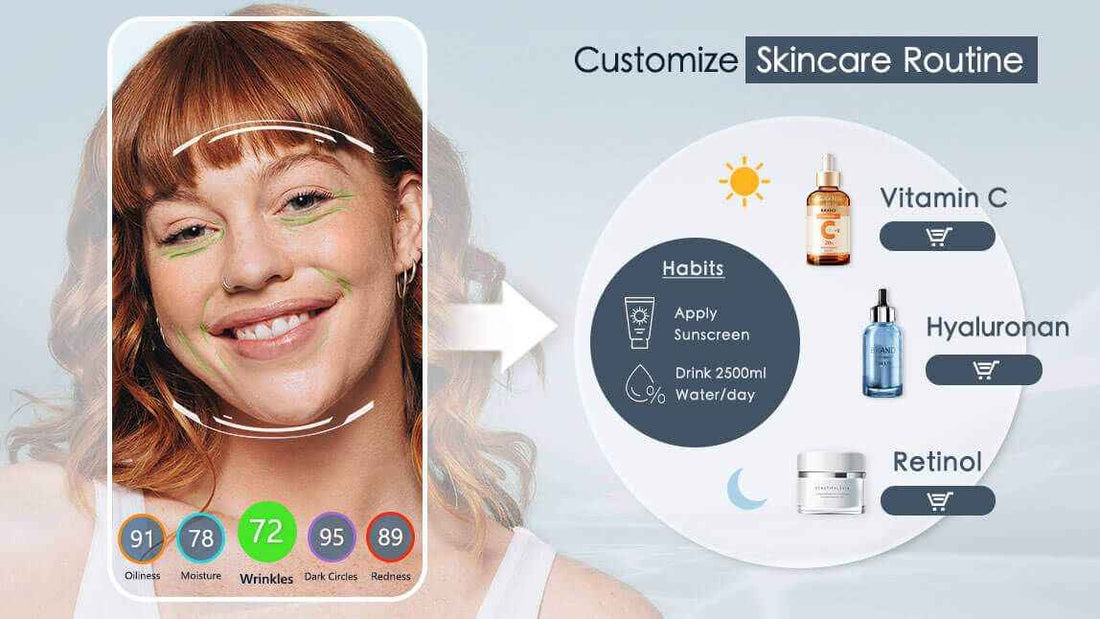
Find Your Perfect Regimen: Glowdar’s Dermatologist-Recommended Skin Quiz
Share
Why One-Size-Fits-All Skincare Routines Fail
The skincare industry perpetuates a pervasive myth: universal solutions for disparate dermatological concerns. This reductive approach ignores the intricate interplay of genetics, environmental factors, and individual skin physiology that determines your unique epidermal needs.
Consider the complexity of your skin barrier function. Transepidermal water loss, sebum production rates, and cellular turnover vary dramatically between individuals. A routine designed for oily, acne-prone skin may exacerbate xerosis in someone with compromised barrier function. Conversely, emollient-rich formulations can trigger comedogenesis in those with hyperactive sebaceous glands.
The consequences extend beyond mere inefficacy. Inappropriate product selection can precipitate contact dermatitis, photoaging acceleration, or paradoxical seborrhea. This is precisely why dermatologists advocate for personalized assessment protocols rather than blanket recommendations.
The Science Behind Personalized Skincare Assessment
Dermatological evaluation encompasses multiple assessment vectors that determine optimal treatment modalities. Professional skin analysis examines sebum distribution patterns, hydration levels, inflammatory markers, and photodamage indicators to create comprehensive patient profiles.
Modern diagnostic approaches utilize advanced technologies like corneometry for hydration measurement and sebummetry for lipid assessment. However, accessible alternatives can achieve similar diagnostic precision through systematic questioning and visual evaluation protocols.
"Personalized skincare isn't just about matching products to skin types—it's about understanding the underlying physiological processes that drive individual skin behavior and addressing them with targeted interventions."
The most effective skincare routine quiz platforms incorporate dermatological assessment principles. They evaluate multiple parameters: skin sensitivity thresholds, current product tolerance, environmental stressors, hormonal influences, and lifestyle factors that impact cutaneous health.
Key Assessment Parameters
Comprehensive skin evaluation requires examining several critical factors. Sebaceous activity levels determine whether your regimen should emphasize mattifying agents or barrier repair. Inflammatory predisposition indicates the need for calming botanicals versus active ingredient tolerance.
Age-related concerns demand specific attention to collagen synthesis stimulation and photoprotection enhancement. Hyperpigmentation assessment involves identifying melanogenesis triggers and determining appropriate depigmenting agent concentrations.
How Glowdar's Dermatologist-Recommended Quiz Works
Glowdar's assessment methodology synthesizes clinical dermatology principles with user-friendly interface design. The platform eliminates choice paralysis through systematic product curation and evidence-based matching algorithms.
The quiz architecture incorporates multi-dimensional evaluation criteria. Initial questions establish baseline skin characteristics—oiliness, sensitivity, current concerns. Progressive inquiry delves deeper into lifestyle factors, product history, and specific dermatological objectives.
- Comprehensive skin type classification beyond basic categories
- Environmental factor assessment including climate and pollution exposure
- Product sensitivity screening to prevent adverse reactions
- Goal-oriented outcome prioritization for targeted results
- Ingredient preference evaluation for optimal formulation matching
The platform's algorithmic processing translates your responses into actionable regimen recommendations. Each suggested product undergoes dermatological vetting to ensure safety and efficacy alignment with your specific needs.
The Assessment Process
Beginning with fundamental skin classification, the quiz progresses through increasingly specific parameters. Initial screening identifies obvious contraindications—severe sensitivity, active dermatitis, medication interactions that might influence product selection.
Subsequent evaluation examines nuanced concerns. Comedogenic predisposition assessment determines appropriate cleansing protocols. Barrier function evaluation guides moisturizer selection and active ingredient introduction timing.
The final phase prioritizes concerns and establishes realistic timelines for visible improvement. This prevents unrealistic expectations while ensuring consistent product usage—the cornerstone of effective skincare outcomes.
Understanding Your Skin Quiz Results
Quiz interpretation requires understanding the relationship between assessment outcomes and recommended interventions. Results typically categorize users into specific phenotypic profiles that guide product selection and application protocols.
Your personalized report should include detailed explanations for each recommendation. Understanding why specific ingredients benefit your skin type enhances compliance and enables informed substitutions when necessary.
| Concern Category | Primary Targets | Recommended Actives |
|---|---|---|
| Acne Management | Sebum regulation, pore decongestion | Salicylic acid, niacinamide, retinoids |
| Aging Prevention | Collagen synthesis, antioxidant protection | Vitamin C, peptides, alpha-hydroxy acids |
| Hyperpigmentation | Melanin inhibition, cellular turnover | Kojic acid, arbutin, hydroquinone alternatives |
| Sensitivity Management | Barrier repair, inflammation reduction | Ceramides, centella asiatica, hyaluronic acid |
Interpreting Ingredient Recommendations
Each suggested formulation serves specific physiological functions within your customized regimen. Humectants address hydration deficits, while occlusives prevent transepidermal water loss. Active ingredients target primary concerns through various biochemical pathways.
Understanding concentration guidelines prevents over-application and minimizes irritation risk. Many users mistakenly assume higher concentrations deliver superior results, when gradual introduction often proves more effective for long-term skin health.
Building Your Personalized Skincare Routine
Transitioning from assessment results to practical implementation requires strategic planning. Abrupt routine changes can disrupt skin homeostasis, potentially causing temporary purging or sensitivity reactions.
Begin with fundamental steps: gentle cleansing, basic moisturization, broad-spectrum photoprotection. These establish a stable foundation before introducing targeted treatments for specific concerns.
Active ingredient integration follows a systematic progression. Start with lower concentrations and alternate-day applications. Monitor skin response carefully, adjusting frequency and potency based on tolerance and efficacy markers.
Layering sequence impacts product absorption and effectiveness. Water-based serums precede oil-based treatments. pH-dependent actives require specific application timing to maintain stability and penetration capabilities.
Common Implementation Questions
How long before seeing results from a dermatologist-recommended skincare routine? Most users observe initial improvements within 4-6 weeks, with significant changes typically appearing after 8-12 weeks of consistent use. Cellular turnover cycles and product accumulation effects determine visible outcome timelines.
Can I modify quiz-recommended routines based on seasonal changes? Seasonal adjustments are often necessary as environmental conditions affect skin behavior. Winter months may require increased occlusive protection, while summer routines benefit from lightweight, mattifying formulations.
What should I do if recommended products cause irritation? Discontinue use immediately and revert to basic cleansing and moisturizing. Contact customer support for alternative recommendations that address your concerns with gentler formulations.
Maximizing Results from Your Quiz-Based Routine
Consistency remains paramount for achieving optimal outcomes from personalized skincare regimens. Sporadic application undermines active ingredient accumulation and prevents meaningful physiological changes in skin behavior.
Documentation enhances routine effectiveness through progress tracking and pattern identification. Photograph skin condition monthly under consistent lighting conditions. Note product tolerance, application ease, and subjective comfort levels.
Environmental modifications complement topical interventions. Humidifier usage during dry seasons, silk pillowcase adoption to reduce friction, and dietary adjustments supporting skin health amplify routine benefits.
Regular reassessment ensures continued routine relevance as skin needs evolve. Hormonal fluctuations, seasonal changes, aging processes, and lifestyle modifications may necessitate regimen adjustments for maintained effectiveness.
Remember that personalized skincare represents an ongoing journey rather than a destination. Your dermatologist-recommended skincare routine quiz results provide the foundation, but attentive observation and gradual refinement create lasting improvements in skin health and appearance.
